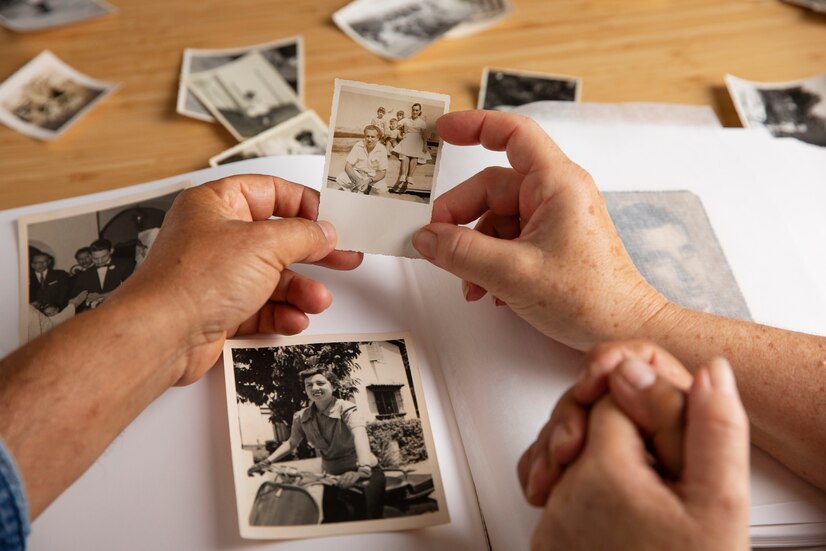In 2017 alone, a staggering 1.2 trillion digital snapshots were captured. This number doesn’t even reflect the photographs taken using traditional film. Each snapshot is a testament to a memory, an encapsulated narrative of personal milestones or joyous occasions.
The memories our photographs evoke are invaluable, and it’s crucial to preserve these treasures. While some precious moments are displayed in frames or lovingly arranged in photo albums, countless others often end up forgotten in the recesses of drawers or confined to storage boxes. To aid you in protecting these significant tokens of the past, we present to you a comprehensive guide for storing your photos securely.
How to Store Old Family Photos?
You Have to Make a Choice
Selecting the ideal photographs to print is as crucial as capturing them. Out of the extensive digital archive filled with treasured memories and random snapshots, only the most meaningful should make it into your tangible photo collection. Think about the legacy you wish to create; a mere ten photos per year can grow into an impressive catalog of 800 keepsakes by your 80th birthday.
Use a straightforward guideline to help decide which images to preserve: choose those that resonate both personally and historically. Channel your inner Marie Kondo and ask if the photo evokes joy. Ensure the subjects are clearly visible and identifiable, and the setting or event captured adds context.
You should approach precious memories on your smartphone in a similar way. To get started, you can run a phone cleaner. Do you want to clean up my phone app or remove duplicate photos? You just need a cleaner phone app that will do the dirty work automatically. For example, it will delete unsuccessful frames or identical photos. You can manually complete the sorting process.
Handle with Care
Hand oils serve as the nemesis for your cherished photographs, wielding the potential to deface them with damage and lingering fingerprints.

To safeguard these irreplaceable memories, donning nitrile gloves or finger cots is foremost among preservation tactics when handling old photos. Should such protective gear be out of reach, a safe alternative is to cradle the picture delicately by its corners, nestled between the soft pads of your index finger and thumb. This technique minimizes the risk of oils transferring to the photo’s surface.
Lay Photographs Flat on Their Backs
Avoid rolling your photographs, as this could result in the front and back adhering to one another, undermining the photo’s integrity and potentially leading to damage when you attempt to straighten it out again. Preserve those precious memories in the best possible condition by storing the photos flat, with their backs down.
Prepare Your Photos
If you’re intrigued by the notion of keeping your cherished photographs in pristine condition, storage methods are paramount. Squeezing them into a long-forgotten shoebox will yield far lesser results compared to securing them in archival-quality, PVC-free sleeves (more insights to follow).
Bucking the common assumption, the age-old practice of using yesteryear’s photo albums might not be the safest haven for your memories—particularly if they’re of the peel-and-stick variety. The adhesives, cardboard, and plastics in these albums can act as silent culprits over time, undermining your photos’ integrity.
Use Acid-Free and Chemically-Neutral Materials
Gone are the days of traditional photo albums with their magnetic or simple adhesive pages—often crafted from just plain plastic, cardboard, and glue. If your cherished photo collections still reside in these relics, it may be time to update to contemporary album options.
When shopping for an updated photo album, be on the lookout for ones marked as “acid-free.” These are usually found at specialized photography stores or retailers that sell art supplies. By choosing an album without harsh chemicals, you’ll help ensure your photographs don’t suffer from unsightly yellowing over time.

Before you tuck your pictures into their new home, make sure to carefully remove any old staples, clips, tape, or elastic bands that could potentially cause damage, such as indentations, scratches, or stains. Although it’s okay to lay your photos in stacks, keep them pristine by placing acid-free paper between each photo.
Conclusion
Images serve as silent narrators of stories that their original holders may never voice. The safeguarding of these visual chronicles is crucial for them to be cherished by descendants. Snapshots of familial celebrations, a child’s significant moments, and hallmark occasions like matrimony and annual festivities hold a special place in the heart of kinship.
To maintain the integrity of such photographs, it’s imperative to use materials devoid of acids and harsh chemicals. To avoid the adhesion of photographs when stored in stacks, interleave them with archival-quality paper. Factors such as environmental moisture, ambient temperature, and the degree of light exposure should also be meticulously regulated.
Jessica has a flair for writing engaging blogs and articles. She enjoys reading and learning new things which enables her to write different topics and fields with ease. She also strives to break down complex concepts and make them easy for anybody to comprehend.





